I'm trying to discover what the specific validation errors are that's causing the validation exception when I update the database. I am reasonably sure that the culprit is the SaveChanges(). I think there's something wrong with one or more properties in one or more of my 3 classes. The only way of resolving the exception is to discover the validation error(s).
I'm a newbie when it comes to this way of debugging, though I'm experienced in several different languages. I've set a breakpoint where indicated so I can see the debug.writeline results, but two problems: it never stops at the breakpoint and I don't see "debug" in the output window dropdown.
What am I not understanding? Is there as better method of trapping validation errors?
Here is the full code in configuration.cs file.
namespace AlbumSong2.Migrations
{
using System;
using System.Data.Entity;
using System.Data.Entity.Migrations;
using System.Data.Entity.Validation;
using System.Diagnostics;
using System.Linq;
internal sealed class Configuration : DbMigrationsConfiguration<AlbumSong2.Model.AlbumDbContext>
{
public Configuration()
{
AutomaticMigrationsEnabled = false;
//if (System.Diagnostics.Debugger.IsAttached == false)
// System.Diagnostics.Debugger.Launch();
}
protected override void Seed(AlbumSong2.Model.AlbumDbContext context)
{
// This method will be called after migrating to the latest version.
// You can use the DbSet<T>.AddOrUpdate() helper extension method
// to avoid creating duplicate seed data. E.g.
//
// context.People.AddOrUpdate(
// p => p.FullName,
// new Person { FullName = "Andrew Peters" },
// new Person { FullName = "Brice Lambson" },
// new Person { FullName = "Rowan Miller" }
// );
//
context.Singers.AddOrUpdate(t => t.SingerName,
new Singer() { SingerName = "Chuck Negron" },
new Singer() { SingerName = "Cory Wells" },
new Singer() { SingerName = "Dan Hutton" });
context.SaveChanges();
try
{
context.Albums.AddOrUpdate(t => t.AlbumName,
new Album()
{
AlbumName = "Three Dog Night",
AlbumTitle = "Seven Separate Fools",
Price = 15,
aLength = 45,
Year = "1972",
isUSA = true,
CurrentSingerId = 1
},
new Album()
{
AlbumName = "Steppenwolf",
AlbumTitle = "Cyan",
Price = 10,
aLength = 35,
Year = "1973",
isUSA = true,
CurrentSingerId = 2
},
new Album()
{
AlbumName = "Grand Funk Railroad",
AlbumTitle = "It Ain't Easy",
Price = 10,
aLength = 35,
Year = "1970",
isUSA = true,
CurrentSingerId = 3
});
context.SaveChanges();
}
catch (DbEntityValidationException e)
{
foreach (var eve in e.EntityValidationErrors)
{
Debug.WriteLine("Entity of type \"{0}\" in state \"{1}\" has the following validation errors:",
eve.Entry.Entity.GetType().Name, eve.Entry.State);
foreach (var ve in eve.ValidationErrors)
{
Debug.WriteLine("- Property: \"{0}\", Value: \"{1}\", Error: \"{2}\"",
ve.PropertyName,
eve.Entry.CurrentValues.GetValue<object>(ve.PropertyName),
ve.ErrorMessage);
}
}
throw;
}
try
{
context.Songs.AddOrUpdate(t => t.SongTitle,
new Song() { SongTitle = "Black and White", sLength = 4, CurrentAlbumId = 1 },
new Song() { SongTitle = "Let Me Seranade You", sLength = 3, CurrentAlbumId = 2 },
new Song() { SongTitle = "Mama Told Me (Not To Come)", sLength = 3, CurrentAlbumId = 3 });
context.SaveChanges();
}
catch (DbEntityValidationException e)
{
foreach (var eve in e.EntityValidationErrors)
{
Debug.WriteLine("Entity of type \"{0}\" in state \"{1}\" has the following validation errors:",
eve.Entry.Entity.GetType().Name, eve.Entry.State);
foreach (var ve in eve.ValidationErrors)
{
Debug.WriteLine("- Property: \"{0}\", Value: \"{1}\", Error: \"{2}\"",
ve.PropertyName,
eve.Entry.CurrentValues.GetValue<object>(ve.PropertyName),
ve.ErrorMessage);
}
}
throw;
}
}
}
}
And the Album class follows:
using System;
using System.Collections.Generic;
using System.Linq;
using System.Web;
using System.ComponentModel.DataAnnotations;
using System.ComponentModel.DataAnnotations.Schema;
namespace AlbumSong2
{
//[Table("Albums")]
public class Album
{
public int AlbumId { get; set; }
[MinLength(5), MaxLength(25), Required]
public string AlbumName { get; set; }
[MinLength(5), MaxLength(25), Required]
public string AlbumTitle { get; set; }
public string Year { get; set; }
[Range(10, 50)]
public int aLength { get; set; }
[Range(1, 15)]
public double Price { get; set; }
public bool isUSA { get; set; }
//navigation property -> each Album has many Songs, indicating dependent (child) entity
public List<Song> Songs { get; set; }
//navigation property -> indicates parent table
public Singer CurrentSinger { get; set; }
[ForeignKey("CurrentSinger")]
public int? CurrentSingerId { get; set; }
}
}
And the song class:
using System;
using System.Collections.Generic;
using System.Linq;
using System.Web;
using System.ComponentModel.DataAnnotations;
using System.ComponentModel.DataAnnotations.Schema;
namespace AlbumSong2
{
//[Table("Songs")]
public class Song
{
public int SongId { get; set; }
[MinLength(2), MaxLength(45)]
[Required]
public string SongTitle { get; set; }
public int sLength { get; set; }
//navigation property -> indicates parent table
public Album CurrentAlbum { get; set; }
[ForeignKey("CurrentAlbum")]
public int CurrentAlbumId { get; set; }
}
}
Finally, the singer class. (There is nothing wrong with the singer table in the database or the code. It's the other two I'm having a problem with):
using System;
using System.Collections.Generic;
using System.Linq;
using System.Web;
using System.ComponentModel.DataAnnotations;
using System.ComponentModel.DataAnnotations.Schema;
namespace AlbumSong2
{
//[Table("Singers")]
public class Singer
{
public int SingerId { get; set; }
[MinLength(5), MaxLength(25)]
[Required]
public string SingerName { get; set; }
//navigation property -> each Singer has many Albums
public List<Album> Albums { get; set; }
}
}
Here's a screenshot of my VS program, showing the breakpoint and the validation error.

